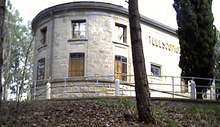Loiano
| Loiano | ||
|---|---|---|

|
|
|
| Country | Italy | |
| region | Emilia-Romagna | |
| Metropolitan city | Bologna (BO) | |
| Local name | Lujàn | |
| Coordinates | 44 ° 16 ′ N , 11 ° 19 ′ E | |
| height | 714 m slm | |
| surface | 52 km² | |
| Residents | 4,381 (Dec 31, 2019) | |
| Population density | 84 inhabitants / km² | |
| Post Code | 40050 | |
| prefix | 051 | |
| ISTAT number | 037034 | |
| Popular name | Loianesi | |
| Website | http://www.comune.loiano.bologna.it/ | |
Loiano is an Italian municipality in the metropolitan city of Bologna with 4381 inhabitants (as of December 31, 2019). It is located in the Savena Valley, 35 km from Bologna , on the state road that connects the capital of Emilia-Romagna with Florence through the Futapass mountain pass .
history
The place name is derived from two possible origins: either from Latin Lollius or lolium ( Lolch , Taumel-Lolch ), although the origin in the church name is much more possible. The area was certainly heavily populated in Roman times , precisely thanks to its transit and connection location between Bologna and Florence. Subsequently, the area was left to the Lombards , then the Franks and finally the margraves of Tuscany . Around 1000 the area passed into the hands of the Ubaldinis (otherwise known as di Mugello ) and the Canossa. Matilde gave away her property in this area to the church of Pisa , then the property was taken over by the Bolognese . The property of the Ubaldinis, however, remained for a long time. The family house of the Counts of Loiano, who ruled in the municipality and in the areas of the Idice and Zena valleys, settled in Loiano . The rulership in a wide area of the Apennines around Bologna triggered a challenge with the Bolognese , whose traffic to Florence they blocked. The long and intense disputes came to an end in 1266 when Ubaldino di Ottocherio da Loiano sold Loiano Castle to the Bolognese. But the disputes were doomed to continue, and the castle itself was destroyed and rebuilt many times. The disputes did not arise until 1402, when Giovanni I finally destroyed the castle. Since then, the parish has followed the events of Bologna and, after the fall of the Papal States , it is incorporated into the Kingdom of Italy . The municipalities of Loiano , Barbarolo , Bisano , Campeggio , Roncastaldo and Scascoli were established as part of the official renovations that followed each other from the Napoleonic era . In 1810, the various municipalities were merged into the municipal areas of Loaino and Roncastaldo, only to finally come to the municipality of Loiano with the above-mentioned localities. In local history, there was a riot from 1850 against conscription. A health insurance company was founded in 1880 and a socialist coalition came to power in the first post-war period, soon replaced by the fascist government. In the second post-war period, an intensive rural exodus took place in the area, which has turned around since the late 1960s.
Attractions
The parish church of Loiano, dedicated to Saints Giacomo and Margherita, is historically valuable. Inside there is a canvas depicting S. Giacomo di Calvaert and a sculpture of the Virgin by Angelo Piò. Two inscriptions can be read here: one reminds us that Pope Pius VII stayed here. The second testifies to an important event, namely that it was here in 1859 that Bettino Ricasoli , Luigi Carlo Farini , Lionello Cipriani , Marco Minghetti and Rodolfo Audinot met and decided to abolish all border controls between Tuscany , Romagna , Modena and Parma and to take future measures to join Central Italy to the Kingdom of Italy. Not to be missed is the Locanda Inn , where the cession of Centos to Ferrara was decided in 1508 and where Goethe stayed in 1786, as is proudly proven in a memorial stone with a quote from an Italian trip .
observatory
The Loiano observatory, managed by the Osservatorio astronomico di Bologna , is open from spring to autumn thanks to the collaboration between the observatory, the municipality of Loiano and the province of Bologna. During the opening months, there are many educational events that include guided observation of the stars (both with the naked eye and telescope), the explanation of the most fascinating aspects of modern astronomy through multimedia techniques, and a scale model of the solar system located in the park.
The observatory has two mirror telescopes : One with a mirror diameter of 60 centimeters and the telescope, which was completed in 1976 and named after G. D. Cassini , with a mirror of 152 centimeters. The first, whose scientific use is now restricted, is mainly used by night visitors during events such as il parco delle stelle (Star Park), while the second is used all year round by Italian and foreign researchers.
Individual evidence
- ↑ Statistiche demografiche ISTAT. Monthly population statistics of the Istituto Nazionale di Statistica , as of December 31 of 2019.
- ↑ a b https://www.oas.inaf.it/it/pubblico/loiano/


